Spatiotemporal Difference Characteristics and Influencing Factors of Tourism Urbanization in China’s Major Tourist Cities
Abstract
:1. Introduction
2. Literature Review
3. Materials and Methods
3.1. Study Area and Data Sources
3.2. Indicators System Construction
3.3. Methods
3.3.1. Entropy Weight Method
- (1)
- Using the range method to standardize the original data:where θ is the year, i is the province, j is the index, and is the j-th index value of province i in year θ.
- (2)
- The original data may appear as zero after dimensionless analysis. To avoid the meaninglessness of individual indicators in the following calculation, the numerical value after becoming dimensionless is translated:
- (3)
- Determine the weight of indicators:
- (4)
- Calculation of information entropy:
- (5)
- Calculation of information utility value:
- (6)
- Calculation of index weight:
3.3.2. State Space Method
3.3.3. Standard Deviation Ellipse
3.3.4. Spatial Autocorrelation
3.3.5. Panel Data Model
4. Results
4.1. Temporal Characteristics of Tourism Urbanization in China’s Major Tourist Cities
4.1.1. Temporal Variation Characteristics of the Tourism Industry Index
4.1.2. Temporal Variation Characteristics of the Urbanization Index
4.1.3. Temporal Variation Characteristics of the Ecological Environment Index
4.1.4. Temporal Variation Characteristics of the Tourism Urbanization Index
4.2. Spatial Characteristics of Tourism Urbanization in Major Tourist Cities of China
4.2.1. Evolution Characteristics of the Spatial Distribution
4.2.2. Global Spatial Characteristics
4.2.3. Local Spatial Features
- (1)
- The first quadrant is H-H (high-value aggregation type), which means that the tourism urbanization indexes of these cities and their neighboring cities are high, and there is spatial correlation between regions. In 2009, this type was concentrated in 13 cities in Beijing-Tianjin-Hebei, the Yangtze River Delta, and the Pearl River Delta. These cities drive tourism urbanization growth with their economic development advantages. Cities of this type were primarily found in the Yangtze River Delta and the Pearl River Delta in 2012, 2015, and 2018. Suzhou, Shanghai, Hangzhou, Guangzhou, Shenzhen, Xiamen, and Sanya are among the cities that reflect this aggregation type.
- (2)
- The second quadrant is L-H (low-high aggregation type); that is, the tourism urbanization index of the city itself is low, while the tourism urbanization level of the surrounding cities is high, and there are significant differences between regions. The cities of this type were distributed in the Beijing-Tianjin-Hebei, Pearl River Delta, Yangtze River Delta, and Chengyu Urban Agglomerations from 2009 to 2018, mainly including Tianjin, Ningbo, Guilin, Kunming, Nanchang, and other cities. These cities’ development levels are somewhat backward, the transmission effect between areas is poor, and high-quality resources from neighboring cities are not properly absorbed or utilized.
- (3)
- The third quadrant is L-L (low-value aggregation type); that is, the tourism urbanization index of cities and adjacent cities is low, and there is spatial correlation between regions. These cities are the greatest in number, and they are concentrated in the central and western regions. Cities in these low-value agglomeration zones should seek breakthroughs in their own growth, identify urban features, achieve mutual promotion between neighboring cities, and play an active role in linking by relying on the surrounding urban agglomerations.
- (4)
- The fourth quadrant is H-L (high-low aggregation type), which means that the city’s tourism urbanization index is high while the surrounding cities’ tourism urbanization index is low, with considerable disparities between areas. In 2009, Lijiang, Huangshan, and Yinchuan were the three major cities representing this type. Over the past decade, the number of cities of this type has increased, and Beijing, Shanghai, Chongqing, and other cities have gradually joined. Most of these cities are economically developed areas and present a unique “siphon effect”. They have obvious agglomeration advantages in all aspects of tourism urbanization development, forming a typical “core-periphery” spatial pattern and showing a certain polarization phenomenon.
4.3. Influencing Factors of the Spatiotemporal Differentiation of Tourism Urbanization in Major Tourist Cities in China
4.3.1. Model Checking
4.3.2. Results and Analysis
- (1)
- Tourism resources are the foundation of tourism development. The p value of the number of A-level scenic spots was less than 0.05. Hence, the original hypothesis should be rejected. It is considered that the number of A-level scenic spots has a significant impact on the tourism urbanization index, with a coefficient of 0.059313. There is a positive correlation between the two. It shows that the tourism urbanization index will increase by 5.93% when the number of A-level scenic spots increases by one unit under the condition of other variables unchanged. From 2009 to 2018, the number of A-level scenic spots increased in most areas. As of 2018, there were 254 A-level scenic spots in Beijing, 113 A-level scenic spots in Shanghai, and 239 A-level scenic spots in Chongqing. The number of scenic spots in the central and western regions is much lower than that in the eastern region.
- (2)
- The level of economic development is the direct driver of tourism demand. The p values of GDP per capita and urban per capita disposable income are greater than 0.05, indicating that their influence on the tourism urbanization index is not significant enough. The coefficient of GDP per capita is 0.186238. Thus, with other factors unchanged, the tourism urbanization index will increase by 18.62% when the GDP per capita increases by one unit. The coefficient of urban per capita disposable income is 0.00960, which has little influence on the tourism urbanization index. The improvement in the economic development level of each city will support the overall development planning of the region, the upgrading of tourism products and the adjustment of the industrial structure. Since 2009, the per capita GDP of Shenzhen has been relatively high. The tourism urbanization index is as high as 0.4730. The per capita GDP of Lijiang is relatively low, and the tourism urbanization index is approximately 0.3260. The eastern regions have a higher per capita GDP and greater economic potential than the western regions. Therefore, the tourism urbanization index in the eastern region is higher than that in the western region.
- (3)
- Traffic conditions are the basic guarantee of tourism urbanization. The p value of end-of-year mileage per capita is greater than 0.05, indicating that it has no significant impact on the tourism urbanization index. This indicates that highway transportation places pressure on the ecological environment, thus hindering the process of tourism urbanization. The role of this variable is not well reflected, which may be due to the lack of control variables or explanatory variables in the panel data model. In 2018, Beijing’s highway mileage reached 22,256 km, Zhangjiajie’s highway mileage increased to 9033 km, and Urumqi’s highway mileage was only 2905 km. The traffic conditions in the eastern, central, and western regions differ significantly. The land is rather flat, and the traffic network is more developed in the eastern part because the area is primarily plains. The transportation situation in the central and western is not convenient due to geography, which is not conducive to the development of tourism urbanization.
- (4)
- National policies and regional development strategies play a guiding role in the process of tourism urbanization. The p value of the comprehensive utilization rate of industrial solid waste is less than 0.05, which is considered to have a significant impact on the tourism urbanization index. The coefficient is 0.026955. Accordingly, with the same other factors, the tourism urbanization index will increase by 2.69% for each unit increase in the comprehensive utilization rate of industrial solid waste. The green coverage rate in built-up areas also has a significant impact on the tourism urbanization index. The coefficient is 0.131176, indicating a positive correlation between the two. This shows that, when other factors are the same, the tourism urbanization index will increase by 13.12% if the green coverage rate in built-up areas increases by one unit. From 2009 to 2018, the green coverage rate in built-up areas decreased from 42.95% to 39.2% in Shanghai and from 39.14% to 35.37% in Harbin, while it increased from 34.27% to 41.9% in Urumqi. It is evident that the ecological environment in the eastern and central regions has been damaged to some extent, whereas the ecological environment in the western region is progressively recovering.
5. Discussion
6. Conclusions
- (1)
- Clear the direction of tourism urbanization. The development levels of China’s tourism industry and urbanization must be improved. We should increase investment in tourism funds and improve basic supporting facilities. Strengthening the ecological civilization construction of tourism cities lays the foundation for the high-level development of tourism urbanization. Promote the coordinated development of the tourism industry and urbanization on the basis of protecting the ecological environment. Areas with a high level of tourism urbanization should continue to maintain advantages and build influential tourism cities. Regions with a low level of tourism urbanization should extend the industrial chain, optimize the industrial structure and reduce pollution.
- (2)
- Narrow the development gap between eastern and western tourism urbanization. Based on the actual development situation, each city should give full play to its own advantages and formulate differentiated development strategies for different target groups. We should expand exchanges and cooperation among cities, strengthen the complementarity of resource advantages, improve market competitiveness, and accelerate the urbanization process. The eastern region should grasp its advantages in economic development and give full play to its radiating and driving role in stimulating the economic development of the surrounding areas. The central and western regions should rationally allocate resources to cultivate new “high-value cluster areas” and narrow the regional gap.
- (3)
- Strengthening the positive influence of driving factors on tourism urbanization. The government should increase the support of financial and technical personnel, train and introduce excellent talent, and improve the quality and level of tourism services. Appropriate adjustments should be made to tourism development planning and protection based on regional resource characteristics and ecological advantages. A sound transportation network system should be established to improve accessibility between cities. In the process of tourism urbanization development, we should adhere to scientific, rational, and orderly development, and improve the quality of the ecological environment.
Author Contributions
Funding
Institutional Review Board Statement
Informed Consent Statement
Data Availability Statement
Conflicts of Interest
References
- National Bureau of Statistics of China. Statistical Bulletin of the People’s Republic of China on National Economic and Social Development in 2019. China Stat. 2020, 3, 8–22. [Google Scholar]
- Sun, Y.Y.; Hou, G.L. Analysis on the Spatial-Temporal Evolution Characteristics and Spatial Network Structure of Tourism Eco-Efficiency in the Yangtze River Delta Urban Agglomeration. Int. J. Environ. Res. Public Health 2021, 18, 2577. [Google Scholar] [CrossRef] [PubMed]
- Jin, D.; Kong, X.S. Quality Evaluation and Spatial Correlation Analysis of Urbanization Development in Hubei Province. Yangtze River Basin Resour. Environ. 2020, 29, 2146–2155. [Google Scholar]
- Pan, Y.; Weng, G.M.; Li, C.H.; Li, J.P. Coupling Coordination and Influencing Factors among Tourism Carbon Emission, Tourism Economic and Tourism Innovation. Int. J. Environ. Res. Public Health 2021, 18, 1601. [Google Scholar] [CrossRef]
- Zhao, L.; Dong, Y.F. Tourism agglomeration and urbanization: Empirical evidence from China. Asia Pac. J. Tour. Res. 2017, 22, 512–523. [Google Scholar] [CrossRef]
- Cui, X.G.; Fang, C.L.; Liu, H.M.; Liu, X.F. Assessing sustainability of urbanization by a coordinated development index for an Urbanization-Resources-Environment complex system: A case study of Jing-Jin-Ji region, China. Ecol. Indic. 2019, 96, 383–391. [Google Scholar] [CrossRef]
- Xiong, J.X.; Wang, W.H.; He, S.H.; Yin, Y.; Tang, C.F. The temporal and spatial differentiation and evolution of tourism urbanization in Dongting Lake area. Econ. Geogr. 2020, 40, 210–219. [Google Scholar]
- Ma, X.F.; Huang, T.T. The dynamic simulation analysis of tourism urbanization response in Zhangjiajie. J. Jishou Univ. Soc. Sci. 2020, 41, 131–141. [Google Scholar]
- Wang, Z.F.; Long, L.Y. Analysis on the mechanism of tourism-driven urbanization from the perspective of time and space: A case study of Zhangjiajie. Resour. Dev. Mark. 2017, 33, 364–368, 378. [Google Scholar]
- Che, L.L.; Zhang, B.B.; Han, X. The spatial and temporal characteristics and dominant factors of tourism urbanization in China. Tour. Forum. 2019, 12, 31–37. [Google Scholar]
- Gao, N.; Ma, Y.F.; Li, T.S.; Bai, K. Research on the coordinated development of tourism industry and urbanization based on coupling model: A case study of Xi’an. Tour. Trib. 2013, 28, 62–68. [Google Scholar]
- Liu, Z.; Guo, H.S.; Ma, X.F. Investigation on the Response Intensity of Tourism Urbanization for People’s Welfare: A Case Study of Zhangjiajie. Int. J. Educ. Econ. 2019, 2, 101–106. [Google Scholar]
- Wang, K.; Huang, Z.F.; Yu, F.L.; Cao, F.D. The spatial effect of China’s urbanization on tourism economy based on spatial panel econometric model. Tour. Trib. 2016, 31, 15–25. [Google Scholar]
- Liao, S.J.; Wu, Y.; Wong, S.W.; Shen, L.Y. Provincial perspective analysis on the coordination between urbanization growth and resource environment carrying capacity (RECC) in China. Sci. Total Environ. 2020, 730, 138964. [Google Scholar] [CrossRef]
- Zhao, Y.B.; Wang, S.J.; Zhou, C.S. Understanding the relation between urbanization and the eco-environment in China’s Yangtze River Delta using an improved EKC model and coupling analysis. Sci. Total Environ. 2016, 571, 862–875. [Google Scholar] [CrossRef]
- Wang, Z.B.; Liang, L.W.; Sun, Z.; Wang, X.M. Spatiotemporal differentiation and the factors influencing urbanization and ecological environment synergistic effects within the Beijing-Tianjin-Hebei urban agglomeration. J. Environ. Manag. 2019, 243, 227–239. [Google Scholar] [CrossRef]
- Joseph, E.M. The socio-economic and environmental impacts of tourism development on the Okavango Delta, north-western Botswana. J. Arid Environ. 2003, 54, 447–467. [Google Scholar]
- Fang, Y.L.; Huang, Z.F.; Duan, Z.X.; Wang, K. Research on the Coupling and Coordination of China’s Tourism Development and Ecological Environment. Econ. Geogr. 2013, 33, 195–201. [Google Scholar]
- Tao, H.; Liu, J.M.; Deng, Y.; Du, A. Tourism sectorization opportunity spectrum model and space partition of tourism urbanization area: A case of the Mayangxi ecotourism area, Fujian province, China. J. Mt. Sci. 2017, 14, 417–431. [Google Scholar] [CrossRef]
- Mullins, P. Cities for Pleasure: The Emergence of Tourism Urbanization in Australia. Built Environ. 1992, 1, 187–198. [Google Scholar]
- Gladstone, D.L. Tourism Urbanization in the United States. Urban Aff. Rev. 1998, 34, 3–27. [Google Scholar] [CrossRef]
- Lu, L.; Ge, J.B. Research progress and enlightenment of tourism urbanization. Geogr. Res. 2006, 25, 741–750. [Google Scholar]
- An, C.Y. Research on connotation and dynamic mechanism of tourism urbanization. Mod. Manag. 2008, 223–224. [Google Scholar] [CrossRef]
- Burak, S. Impact of urbanization and tourism on coastal environment. Ocean Coast. Manag. 2004, 47, 515–527. [Google Scholar] [CrossRef]
- Jones, C.; Munday, M. Exploring the environmental con- sequences of Tourism: A satellite account approach. J. Travel Res. 2007, 46, 164–172. [Google Scholar] [CrossRef]
- Zhang, T.; Li, L. Research on temporal and spatial variations in the degree of coupling coordination of tourism-urbanization-ecological environment: A case study of Heilongjiang, China. Environ. Dev. Sustain. 2020, 2, 8474–8491. [Google Scholar]
- Hu, Z.P.; Huang, X.X.; Fu, C.; Yu, D.J. Analysis on the interaction of tourism industry, urbanization and ecological environment in the Poyang Lake region. Yangtze River Basin Resour. Environ. 2015, 24, 2012–2020. [Google Scholar]
- Yang, X.P.; Zhang, D.C.; Yuan, P.P.; Zhang, X.B. Research on the coupling coordination degree of tourism-eco-environment-urbanization system: A case study of Ningxia Hui Autonomous Region. Math. Prac. Cogn. 2020, 50, 35–47. [Google Scholar]
- Deng, C. Analysis of the Coupling and Coordinated Development of Tourism Industry-Urbanization-Ecological Environment in Shanxi Province. Reg. Res. Dev. 2018, 37, 85–89. [Google Scholar]
- Ma, X.F.; Zhou, H. Spatial-temporal distribution and heterogeneity analysis of influencing factors of tourism urbanization response driven by traffic—Taking Xiangxi as an example. Bus. Res. 2020, 27, 76–88. [Google Scholar]
- Liu, S. The spatiotemporal evolution and influence mechanism of the response intensity of tourism urbanization in the context of global tourism: A case study of 12 provinces in western China. Reg. Res. Dev. 2020, 39, 94–99, 106. [Google Scholar]
- Liu, Y.J.; Tang, J.X.; Ma, X.F. Study on the evolution and model of the spatio-temporal pattern of tourism urbanization in contiguous destitute areas: A case study of Wuling Mountain in Hunan. Econ. Geogr. 2019, 39, 214–222, 230. [Google Scholar]
- Rong, H.F.; Tao, Z.M.; Liu, Q.; Xu, Y.; Cheng, H.F. Spatiotemporal evolution of the coupling and coordination of tourism industry-urbanization-ecological environment in southern Anhui. Res. Soil Water Conserv. 2019, 26, 280–285. [Google Scholar]
- Han, W.Y.; Chen, X.P.; Pang, J.X.; Wang, N.F.; Yu, Y.H. Research on the Coupling and Coordinative Development of Urbanization-Ecological Environment-Tourism Industry—Taking 9 provinces (regions and cities) along the Silk Road Economic Belt as examples. J. Lanzhou Univ. Nat. Sci. 2018, 54, 762–769. [Google Scholar]
- Çevirgen, A.; Kesgin, M. Local authorities’ and NGOs’ perceptions of tourism development and urbanization in Alanya. Tour. Int. Interdiscip. J. 2007, 55, 309–322. [Google Scholar]
- Dandapath, P.; Mondal, M. Urbanization and its impact on coastal ecotourism in West Bengal. Int. J. Sci. Res. 2013, 2, 114–119. [Google Scholar]
- Lu, L.; Yu, R.; Zhu, F.B.; Wang, Y.Q.; Wang, W. Research on the characteristics and mechanism of tourism urbanization in Tangkou town of Huangshan city based on the sociological perspective. Hum. Geogr. 2010, 25, 19–24. [Google Scholar]
- Cheng, H.; Xu, Q. Study on the Coupling Relationship between China’s Urbanization-Tourism-Ecological Time and Space Based on Geo-Detectors. J. Zhongzhou Univ. 2019, 36, 21–27. [Google Scholar]
- Wang, Q.; Lu, L.; Yang, X.Z. The resilience measurement and influence mechanism of the social-ecological system of Qiandao Lake. Acta Geogr. Sin. 2015, 70, 779–795. [Google Scholar]
- Zhou, C.; Feng, X.G.; Tang, R. Analysis and prediction of the coordinated development of regional economy-ecological environment-tourism industry coupling—Taking provinces and cities along the Yangtze River Economic Belt as examples. Econ. Geogr. 2016, 36, 186–193. [Google Scholar]
- Wang, X.Y.; Lu, X.J.; Zhu, W.L. Analysis and Evaluation of Factors Affecting the Tourism Development of my country’s Major Tourist Cities. Econ. Geogr. 2020, 40, 198–209. [Google Scholar]
- Cheng, Y.W.; Zhang, H. Research on the Identification and Classification of Chinese Tourist Cities Based on Urban Function Theory. Mod. City Res. 2014, 104–109. [Google Scholar] [CrossRef]
- Wang, L.; Luo, W.T.; Li, Y.J. Research on the Construction of Evaluation System of Tourism Urbanization Level in Ethnic Areas—Taking Enshi Tujia and Miao Autonomous Prefecture as an Example. J. Cent. Chin. Norm. Univ. Nat. Sci. 2021, 55, 137–146. [Google Scholar]
- Huang, C.; Yin, K.D.; Liu, Z.; Cao, T.G. Spatial and Temporal Differences in the Green Efficiency of Water Resources in the Yangtze River Economic Belt and Their Influencing Factors. Int. J. Environ. Res. Public Health 2021, 18, 3101. [Google Scholar] [CrossRef]
- Zhou, C.; Jin, C.; Zhao, B.; Zhang, F. Study on the inter-provincial spatial differences of the coordinated development of regional economy-ecology-tourism coupling. Arid Land Resour. Environ. 2016, 30, 203–208. [Google Scholar]
- Xie, X.; Sun, H.; Gao, J.; Chen, F.F.; Zhou, C.S. Spatiotemporal Differentiation of Coupling and Coordination Relationship of Tourism-Urbanization-Ecological Environment System in China’s Major Tourist Cities. Sustainability 2021, 13, 5867. [Google Scholar] [CrossRef]
- Xia, X.X.; Lin, K.X.; Ding, Y.; Dong, X.L.; Sun, H.J.; Hu, B.B. Research on the Coupling Coordination Relationships between Urban Function Mixing Degree and Urbanization Development Level Based on Information Entropy. Int. J. Environ. Res. Public Health 2020, 18, 242. [Google Scholar] [CrossRef] [PubMed]
- Chen, P.Y. Effects of normalization on the entropy-based TOPSIS method. Expert Syst. Appl. 2019, 136, 33–41. [Google Scholar] [CrossRef]
- Li, H.; Wang, W.J.; Zhang, Y.; Hua, Y.L.; Li, Y.D. Research on Ecotourism Carrying Capacity of “One Belt One Road” Heritage Corridor Based on State Space Model. Chin. Landsc. Arch. 2020, 36, 18–23. [Google Scholar]
- Xiong, J.X.; Chen, D.L.; Xie, X.M. Study on Comprehensive Evaluation of Ecological Carrying Capacity of Dongting Lake Area Based on State Space Method. Econ. Geogr. 2012, 32, 138–142. [Google Scholar]
- Ruan, W.Q.; Li, Y.Q.; Zhang, S.N.; Liu, C.H. Evaluation and drive mechanism of tourism ecological security based on the DPSIR-DEA model. Tour. Manag. 2019, 75, 609–625. [Google Scholar] [CrossRef]
- Zhang, S.R.; Zhong, L.S.; Ju, H.R.; Wang, Y.J. Land Border Tourism Resources in China: Spatial Patterns and Tourism Management. Sustainability 2019, 11, 236. [Google Scholar] [CrossRef] [Green Version]
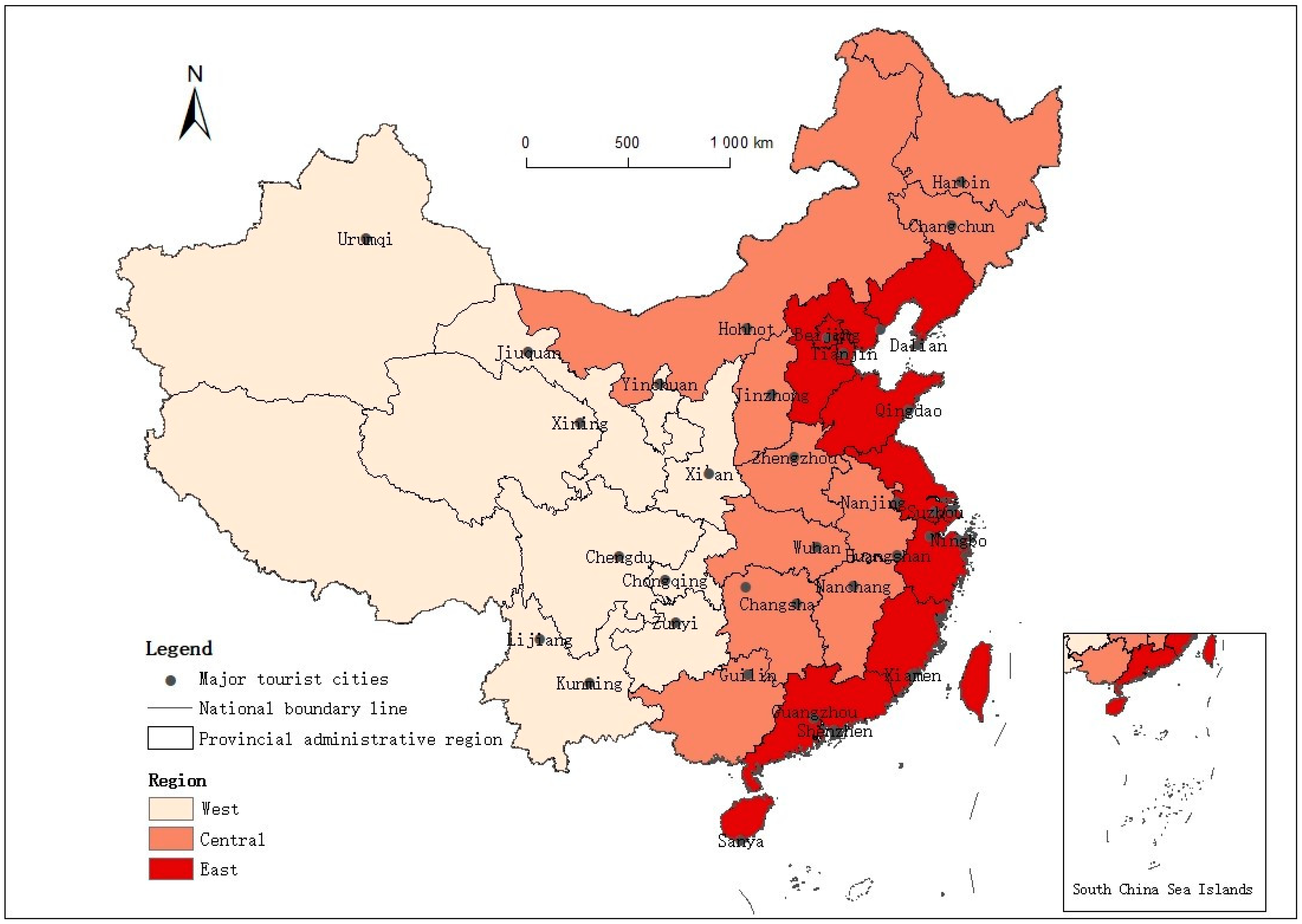
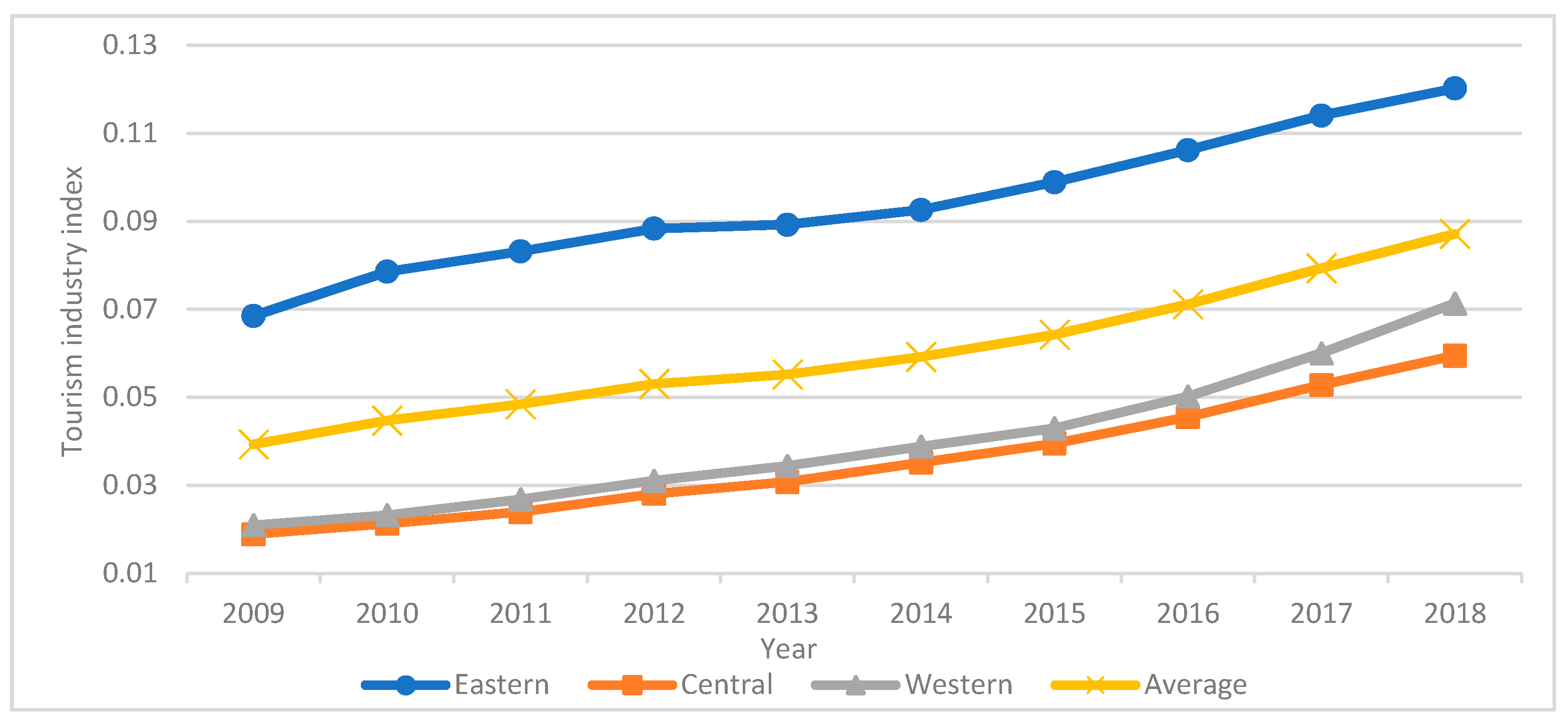
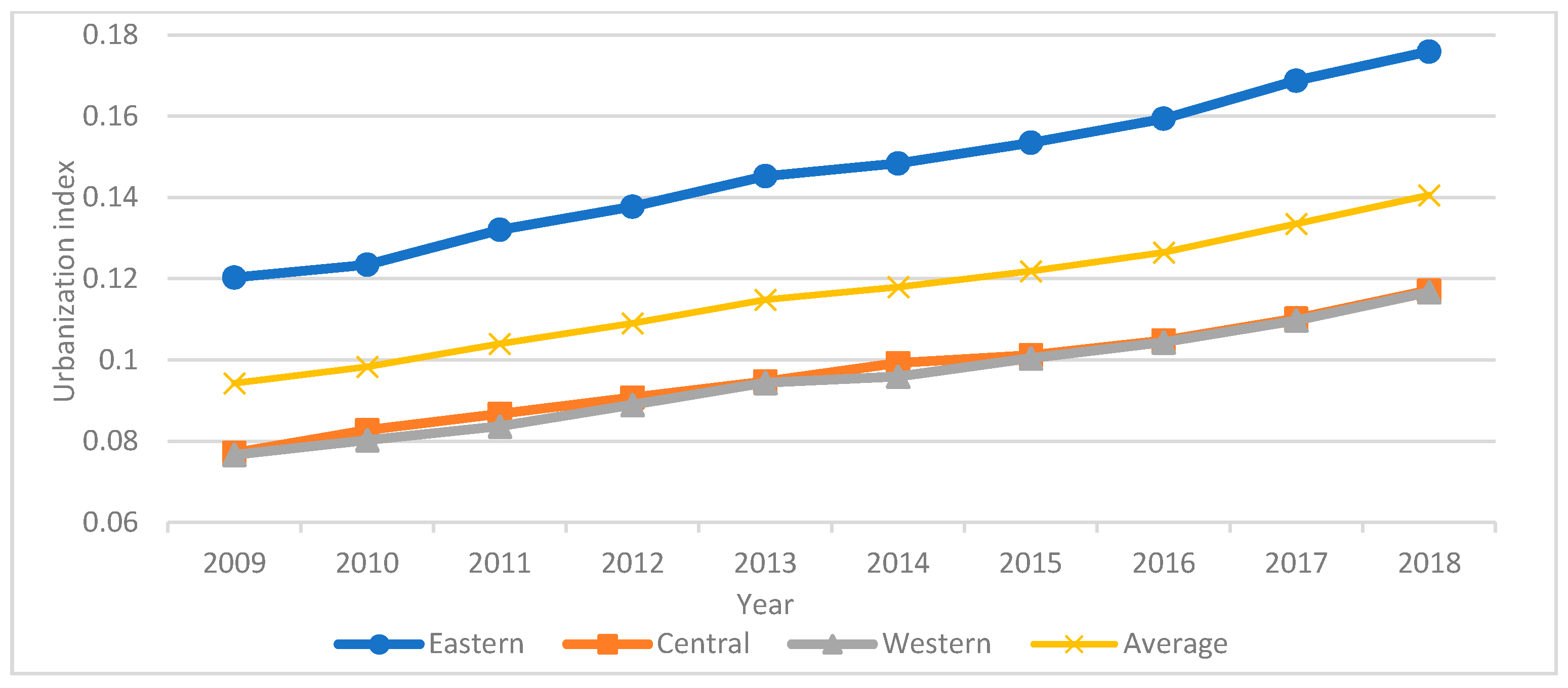
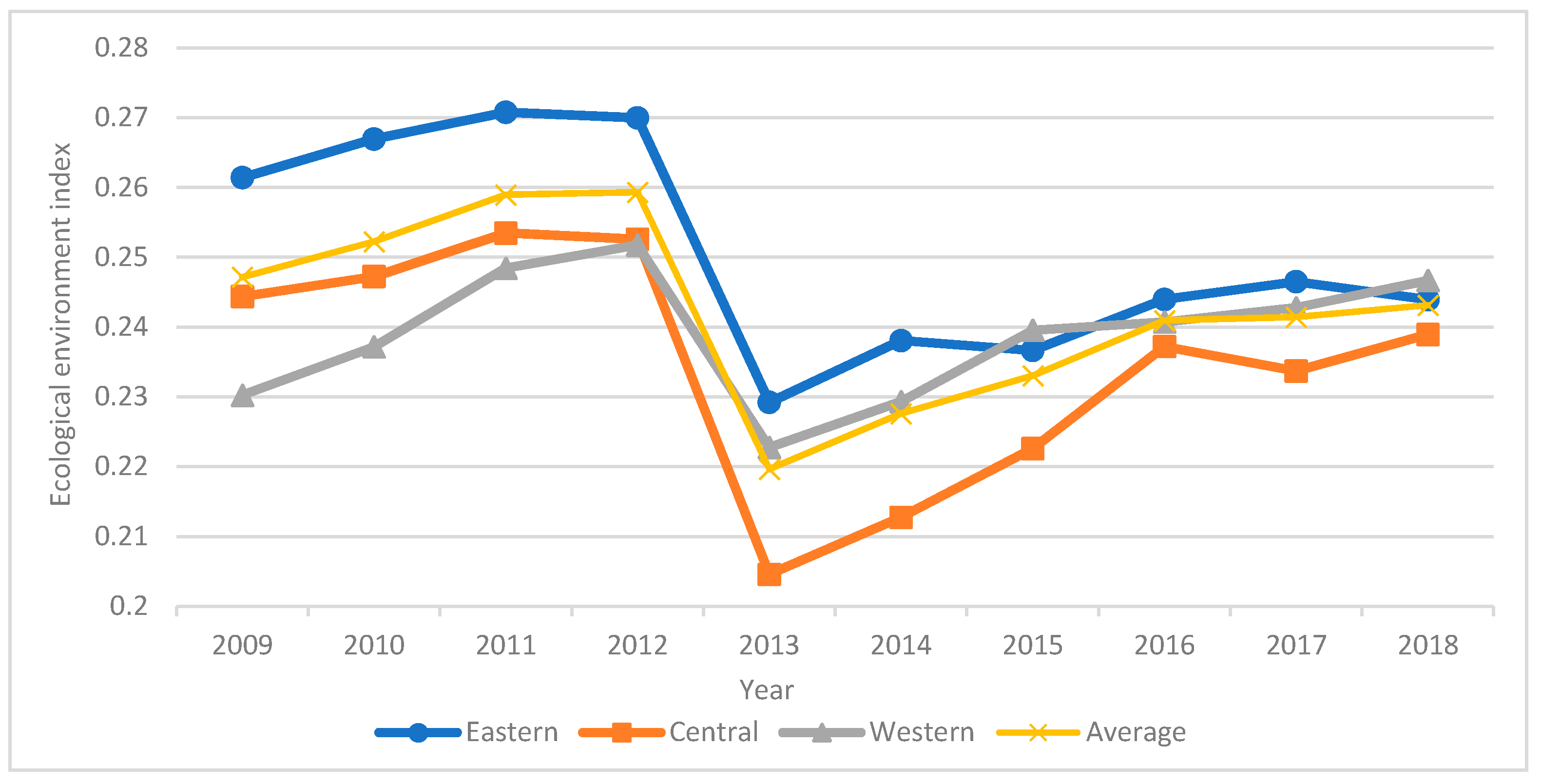

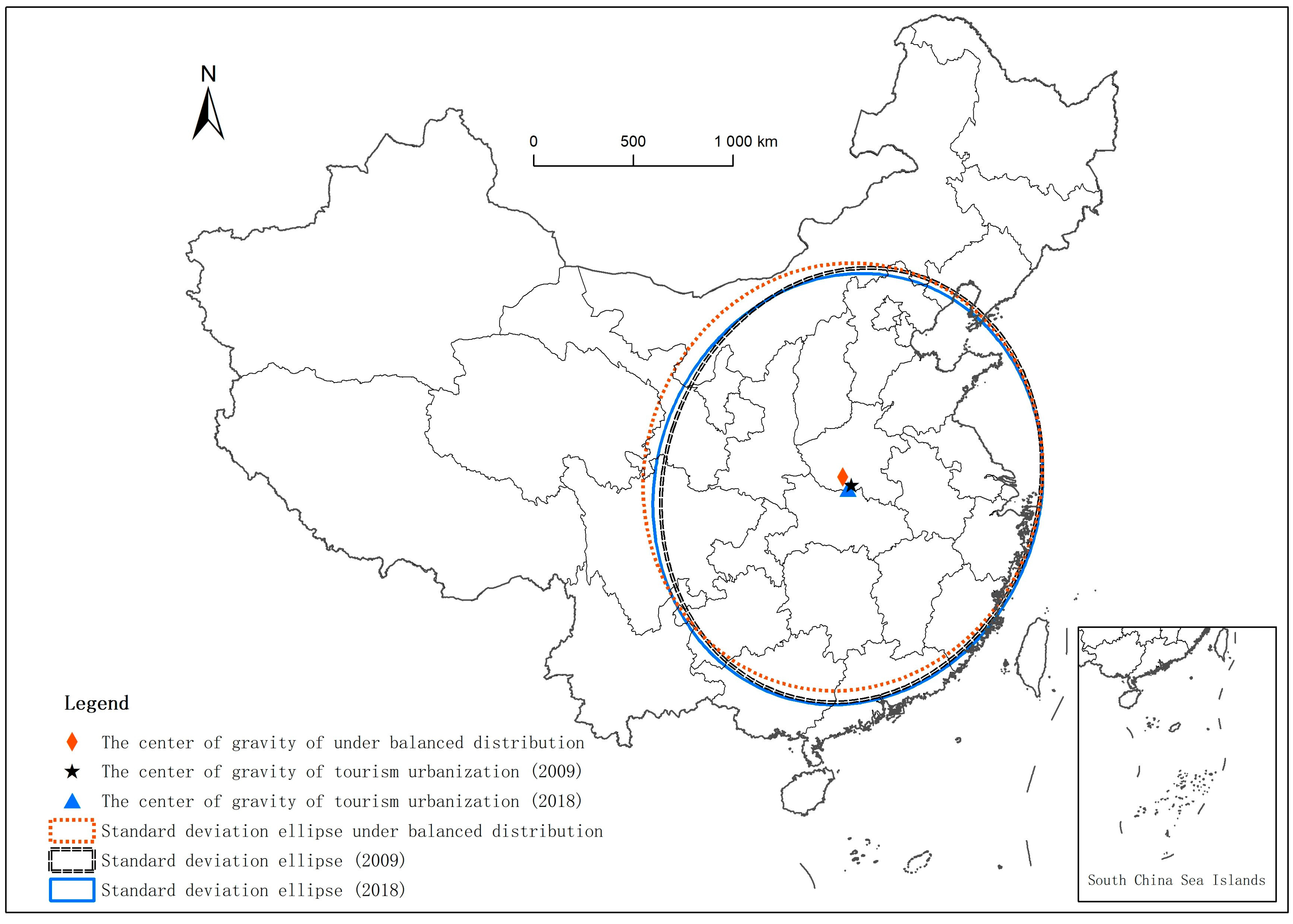
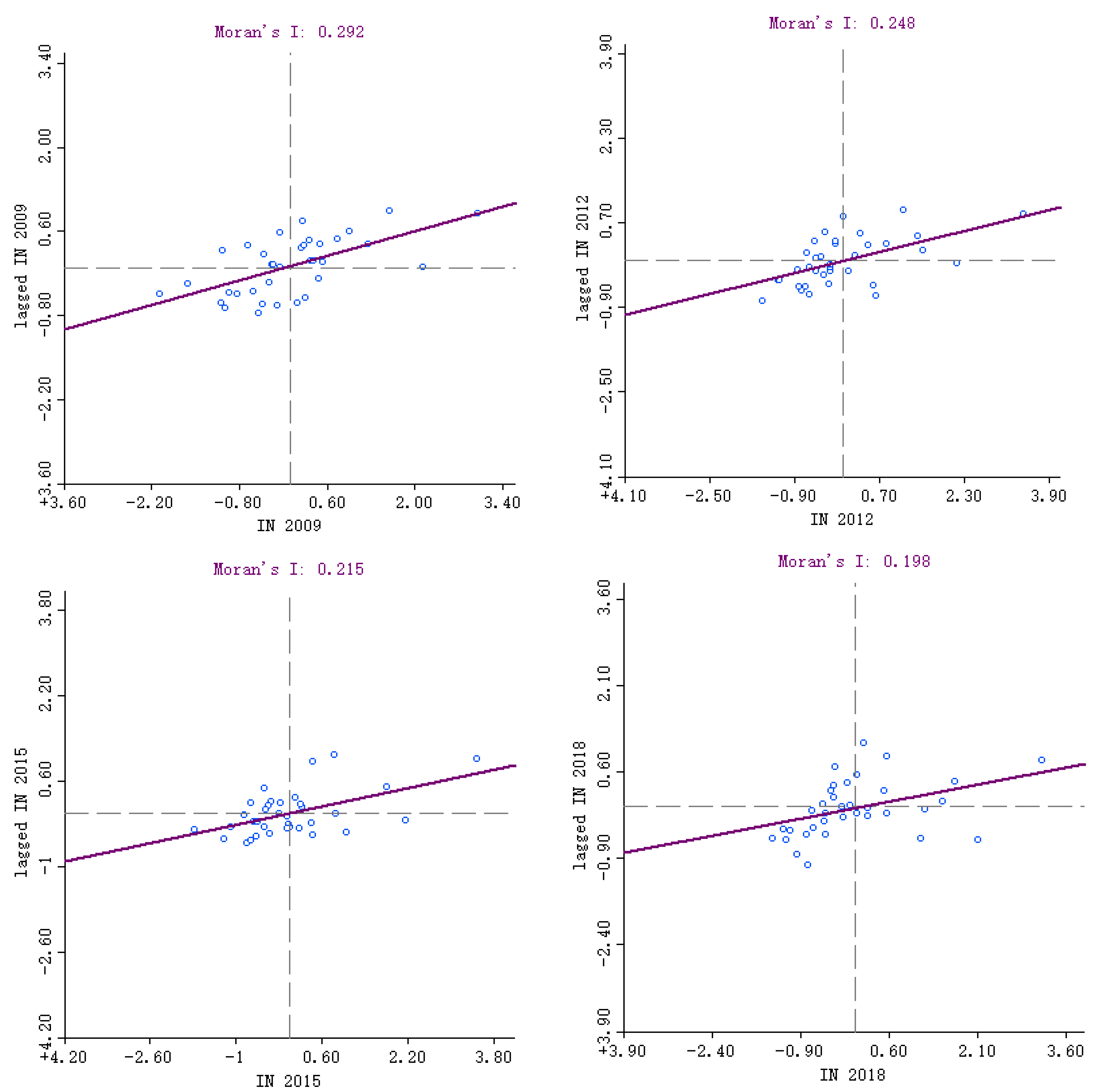
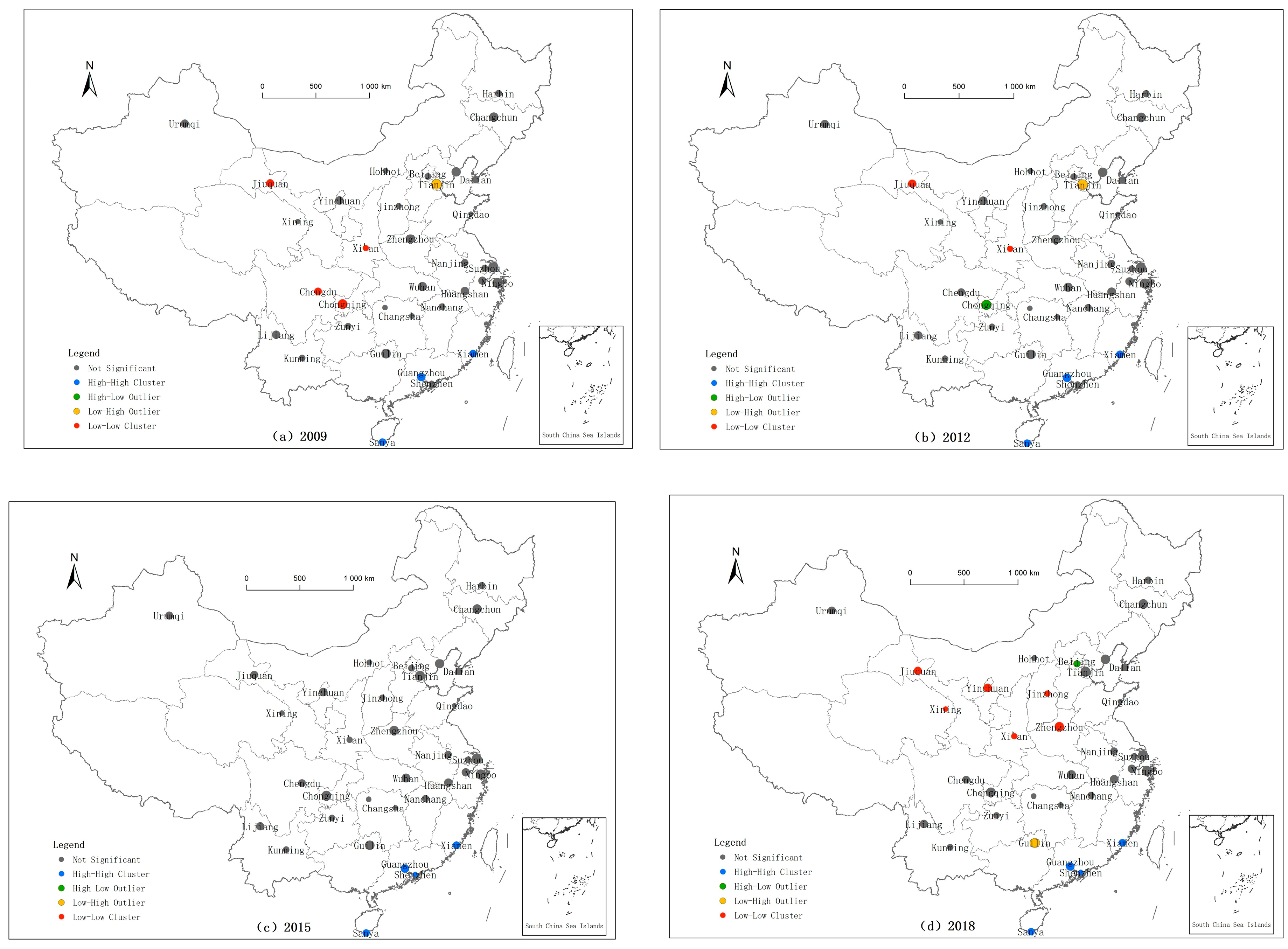
| Subsystem | Evaluation Index | Unit | Nature | Weight |
|---|---|---|---|---|
| Tourism Industry | Number of inbound tourists | 10,000 people | + | 0.1501 |
| Domestic tourism | 10,000 people | + | 0.1067 | |
| Foreign exchange earnings from tourism | USD 10,000 | + | 0.1667 | |
| Domestic tourism revenue | 100,000,000 yuan | + | 0.1006 | |
| Total tourism revenue | 100,000,000 yuan | + | 0.0998 | |
| Tourism income as a percentage of GDP | % | + | 0.1291 | |
| Number of A-level scenic spots | a | + | 0.0795 | |
| Number of star hotels | a | + | 0.1056 | |
| Number of travel agencies | a | + | 0.0619 | |
| Urbanization | Urban per-capita disposable income | yuan/person | + | 0.0956 |
| Urban road area per capita | m2/person | + | 0.1008 | |
| End-of-year mileage per capita | km/person | + | 0.1001 | |
| Urban end-of-year registered unemployment rate | % | - | 0.0754 | |
| Number of public vehicles in operation | a | + | 0.2788 | |
| GDP per capita | yuan/person | + | 0.1037 | |
| Secondary industry as a percentage of GDP | % | + | 0.0475 | |
| Tertiary industry as a percentage of GDP | % | + | 0.0938 | |
| Proportion of employed population in the secondary industry | % | + | 0.0533 | |
| Proportion of employed population in the tertiary industry | % | + | 0.0510 | |
| Ecological Environment | Industrial sulfur dioxide emissions | 10,000 tons | - | 0.0517 |
| Industrial soot emissions | 10,000 tons | - | 0.0100 | |
| Industrial wastewater discharge | 10,000 tons | - | 0.0841 | |
| Green coverage rate in built-up areas | % | + | 0.1372 | |
| Per capita park green area | hm2/person | + | 0.2396 | |
| Days of air quality at level 2 or higher | a | + | 0.2031 | |
| Comprehensive utilization rate of industrial solid waste | % | + | 0.1375 | |
| Centralized treatment rate of urban sewage | % | + | 0.0693 | |
| Pollution-free treatment rate of domestic garbage | % | + | 0.0675 |
| Year | Moran’s I Index | Z Score | p Value |
|---|---|---|---|
| 2009 | 0.202521 | 2.870520 | 0.004098 |
| 2010 | 0.227301 | 3.186548 | 0.001440 |
| 2011 | 0.220067 | 3.114921 | 0.001840 |
| 2012 | 0.197731 | 2.867791 | 0.004133 |
| 2013 | 0.199862 | 2.852398 | 0.004339 |
| 2014 | 0.163579 | 2.403359 | 0.016245 |
| 2015 | 0.193124 | 2.842416 | 0.004477 |
| 2016 | 0.187318 | 2.727239 | 0.006387 |
| 2017 | 0.214422 | 3.057489 | 0.002232 |
| 2018 | 0.225018 | 3.162057 | 0.001567 |
| Year | H-H | L-H | L-L | H-L |
|---|---|---|---|---|
| 2009 | Beijing, Suzhou, Shanghai, Hangzhou, Guangzhou, Shenzhen, Xiamen, Sanya, Qinhuangdao, Dalian, Qingdao, Kunming, Hohhot, Changchun (14) | Ningbo, Guilin, Jinzhong, Nanchang, Nanjing, Tianjin and Harbin (7) | Zunyi, Zhangjiajie, Jiuquan, Chongqing, Chengdu, Changsha, Wuhan, Xi‘an, Zhengzhou, Xining, Urumqi (11) | Lijiang, Huangshan, Yinchuan (3) |
| 2012 | Suzhou, Shanghai, Hangzhou, Guangzhou, Shenzhen, Xiamen, Sanya, Qinhuangdao (8) | Ningbo, Guilin, Dalian, Kunming, Nanchang, Tianjin, Changchun, Xiamen(8) | Zunyi City, Zhangjiajie City, Jiuquan City, Jinzhong City, Chengdu City, Changsha City, Wuhan City, Xi’an, Zhengzhou, Nanjing, Xining, Yinchuan, Urumqi, Hohhot, Harbin (15) | Lijiang, Huangshan, Chongqing and Beijing (4) |
| 2015 | Suzhou, Shanghai, Hangzhou, Guangzhou, Shenzhen, Xiamen, Sanya (7) | Ningbo, Guilin, Dalian, Kunming, Nanchang, Tianjin, Changchun, Chengdu (8) | Zunyi, Zhangjiajie, Jiuquan, Jinzhong, Changsha, Wuhan, Zhengzhou, Nanjing, Xining, Xi’an, Yinchuan, Urumqi, Hohhot and Harbin (14) | Lijiang, Huangshan Qingdao, Chongqing, Shanghai and Beijing (6) |
| 2018 | Suzhou, Shanghai, Hangzhou, Guangzhou, Shenzhen, Xiamen, Sanya (7) | Ningbo, Guilin, Kunming, Nanchang, Changchun, Qinhuangdao, Chengdu, Changsha (8) | Zhangjiajie, Jiuquan, Jinzhong, Dalian, Wuhan, Xi‘an, Zhengzhou, Xining, Yinchuan, Tianjin, Urumqi, Hohhot, Harbin (13) | Lijiang, Zunyi, Huangshan, Chongqing, Qingdao, Nanjing and Beijing (7) |
| Effects Test | Statistic | Chi-Sq.d.f. | Prob. |
|---|---|---|---|
| Cross-section random | 27.000958 | 6 | 0.0001 |
| Effects Test | Statistic | d.f. | Prob. |
|---|---|---|---|
| Cross-section F | 60.628370 | (34,309) | 0.0000 |
| Variable | Coefficient | Std.Error | t-Statistic | Prob |
|---|---|---|---|---|
| ln C | −2.453413 | 0.259174 | −9.466280 | 0.0000 |
| ln J | 0.059313 | 0.019613 | 3.024223 | 0.0027 |
| ln G | 0.054267 | 0.030994 | 1.750868 | 0.0810 |
| ln R | 0.009660 | 0.032415 | 0.298026 | 0.7659 |
| ln K | −0.037548 | 0.032006 | −1.173139 | 0.2416 |
| ln F | 0.026955 | 0.013670 | 1.971902 | 0.0495 |
| ln L | 0.131176 | 0.019555 | 6.708153 | 0.0000 |
| Weighted Statistics | ||||
| R-squared | 0.922012 | F-statistic | 91.32909 | |
| Adjusted-R-squared | 0.911917 | Prob (F-statistic) | 0.000000 | |
Publisher’s Note: MDPI stays neutral with regard to jurisdictional claims in published maps and institutional affiliations. |
© 2021 by the authors. Licensee MDPI, Basel, Switzerland. This article is an open access article distributed under the terms and conditions of the Creative Commons Attribution (CC BY) license (https://creativecommons.org/licenses/by/4.0/).
Share and Cite
Xie, X.; Zhang, L.; Sun, H.; Chen, F.; Zhou, C. Spatiotemporal Difference Characteristics and Influencing Factors of Tourism Urbanization in China’s Major Tourist Cities. Int. J. Environ. Res. Public Health 2021, 18, 10414. https://doi.org/10.3390/ijerph181910414
Xie X, Zhang L, Sun H, Chen F, Zhou C. Spatiotemporal Difference Characteristics and Influencing Factors of Tourism Urbanization in China’s Major Tourist Cities. International Journal of Environmental Research and Public Health. 2021; 18(19):10414. https://doi.org/10.3390/ijerph181910414
Chicago/Turabian StyleXie, Xia, Lei Zhang, Hui Sun, Feifei Chen, and Chunshan Zhou. 2021. "Spatiotemporal Difference Characteristics and Influencing Factors of Tourism Urbanization in China’s Major Tourist Cities" International Journal of Environmental Research and Public Health 18, no. 19: 10414. https://doi.org/10.3390/ijerph181910414
APA StyleXie, X., Zhang, L., Sun, H., Chen, F., & Zhou, C. (2021). Spatiotemporal Difference Characteristics and Influencing Factors of Tourism Urbanization in China’s Major Tourist Cities. International Journal of Environmental Research and Public Health, 18(19), 10414. https://doi.org/10.3390/ijerph181910414






